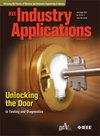Integrating Electrified Logistics Systems Into Power Distribution Network: A Joint-Optimization Planning Approach
IF 4.5
2区 工程技术
Q2 ENGINEERING, ELECTRICAL & ELECTRONIC
引用次数: 0
Abstract
Integrating electrified logistics systems with power distribution networks (PDNs) poses challenges for jointly optimizing charging infrastructure deployment and vehicle routing. Conventional methods often fail to jointly address the interdependencies between these two systems, leading to suboptimal planning and increased operational costs. To address this issue, a two-stage joint-optimization framework is proposed to simultaneously optimize EV charging station siting and electric logistics vehicle (ELV) routing within PDNs. In the first stage, a multi-objective optimization model is employed to determine optimal charging station locations, balancing infrastructure costs and traffic flow capture efficiency. In the second stage, an adaptive routing model integrates charging constraints to optimize ELV operational costs. A hybrid optimization algorithm, combining self-adaptive MOEA/D and genetic algorithm with best-first search (GABFS), is developed to enhance computational efficiency and solution robustness. The proposed approach is validated on a benchmark distribution network with logistics scenarios, demonstrating significant reductions in both capital investment for charging infrastructure and logistics operational costs. The findings underscore the importance of coordinated charging and logistics planning in accelerating the transition towards sustainable electrified logistics networks.电气化物流系统与配电网集成:一种联合优化规划方法
将电气化物流系统与配电网络(pdn)集成,对共同优化充电基础设施部署和车辆路径提出了挑战。传统的方法往往不能共同解决这两个系统之间的相互依赖性,导致次优规划和增加的运营成本。为了解决这一问题,提出了一种两阶段联合优化框架,在pdn内同时优化电动汽车充电站选址和电动物流车路径。第一阶段采用多目标优化模型确定最优充电站位置,平衡基础设施成本和交通流捕获效率;在第二阶段,自适应路径模型集成了充电约束,以优化电动汽车的运行成本。为了提高计算效率和解的鲁棒性,提出了一种结合自适应MOEA/D和最优优先搜索(GABFS)的遗传算法的混合优化算法。所提出的方法在具有物流场景的基准分销网络上进行了验证,证明了充电基础设施的资本投资和物流运营成本的显着降低。研究结果强调了协调充电和物流规划在加速向可持续电气化物流网络过渡中的重要性。
本文章由计算机程序翻译,如有差异,请以英文原文为准。
求助全文
约1分钟内获得全文
求助全文
来源期刊

IEEE Transactions on Industry Applications
工程技术-工程:电子与电气
CiteScore
9.90
自引率
9.10%
发文量
747
审稿时长
3.3 months
期刊介绍:
The scope of the IEEE Transactions on Industry Applications includes all scope items of the IEEE Industry Applications Society, that is, the advancement of the theory and practice of electrical and electronic engineering in the development, design, manufacture, and application of electrical systems, apparatus, devices, and controls to the processes and equipment of industry and commerce; the promotion of safe, reliable, and economic installations; industry leadership in energy conservation and environmental, health, and safety issues; the creation of voluntary engineering standards and recommended practices; and the professional development of its membership.
 求助内容:
求助内容: 应助结果提醒方式:
应助结果提醒方式:


